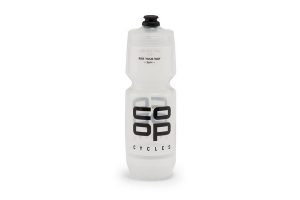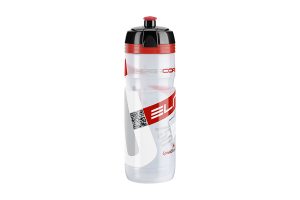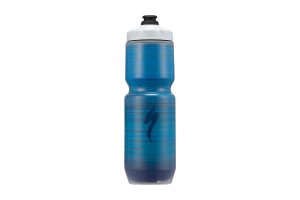The 7 Best Bike Water Bottles in 2019
Are you looking to buy water bottles for cycling?
I know. It’s easy to just buy the cheapest ones and leave them at that. After all, it’s a plastic bottle, what more do you need to know?
A lot.
If you ride a lot, a water bottle choice can make a significant experience to that ride. It can mean the difference between a warm or cold drink on a hot summer day. Like everything else in cycling, science and marketing play a part in your choice of a water bottle.
On this page, I’ll discuss what you should look for in a water bottle, answer some frequently asked questions and also share with you some of my favorites.
A Quick Glance : Our Favorite Cycling Water Bottles
Co-op Cycles Purist
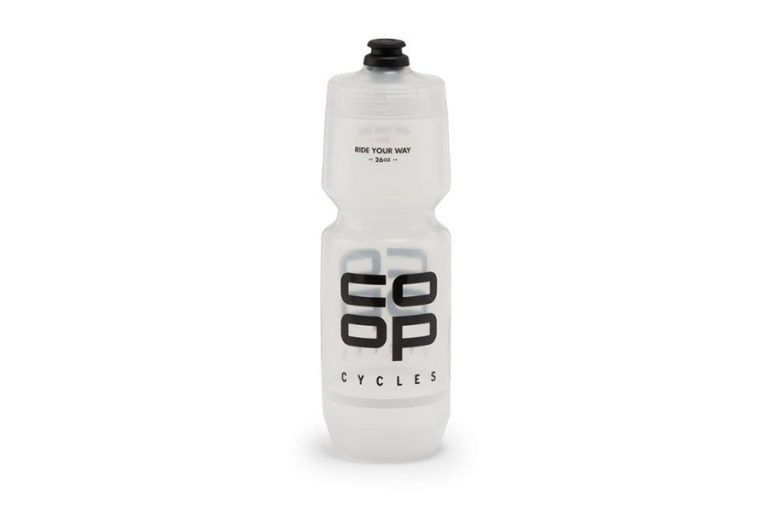
- Volume : 26 fl. oz (750ml)
- Colors : 3
Look no further if you’re looking for a budget water bottle.
Leaking, mold, insufficient water flow: these are all issues that plague cyclists when it comes to drinking from a water bottle. Co-op, the cycling brand of outdoor outfitting giant REI, addresses all these issues with the Purist.
The interior of this innovative water bottle is treated with silicon dioxide to prevent odors, mold growth, and staining, ensuring that all your drinking is the drink you put into the bottle. Its patented MoFlo cap features a wider water channel that Co-op says provides up to 50% greater flow than conventional water bottles.
- Pros : Patented MoFlo cap provides up to 50% greater flow than conventional water bottles.
- Cons : Loud Co-op branding might not be for some.
Elite Super Corsa
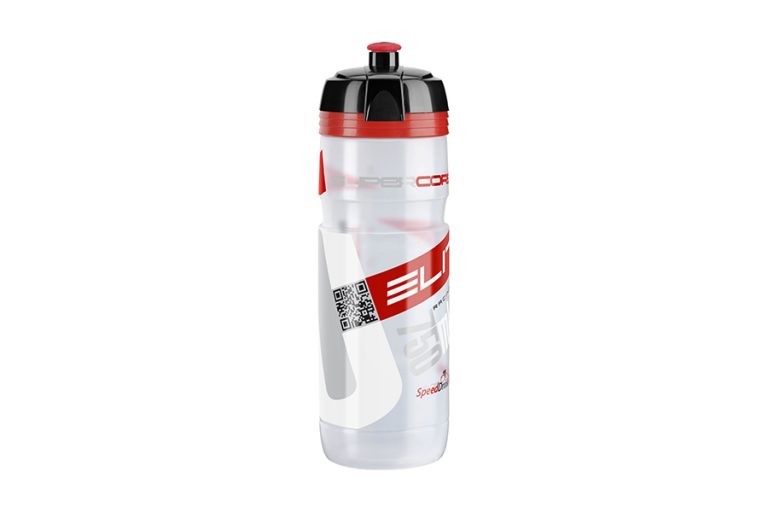
- Volume : 26 fl. oz (750ml)
- Colors : 1
At 750ml, the Elite Super Corsa is a large volume water bottle.
Having a pair of these on the bike can last you several hours on the bike and help keep you sufficiently hydrated regardless of the temperature.
These bottles have a secure nozzle, flexible skin, and are easy to grip. They also fit perfectly into most bottle cages. Obviously, they work best with Elite bottle cages.
- Pros : Easy to wash nozzle.
- Cons : Plastic tends to get yellowish and degrade over 9 to 12 months of usage.
Specialized Purist
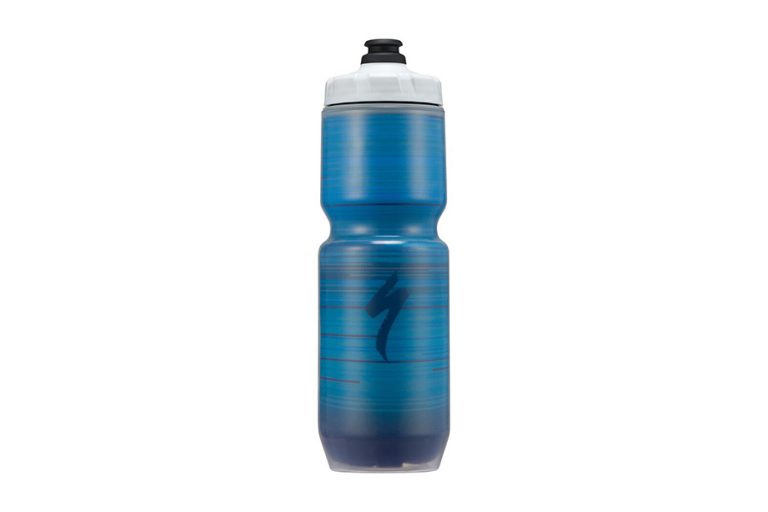
- Volume : 23 fl. oz (680ml)
- Colors : 1
Is there anything more gag-worthy than reaching for your water bottle in the middle of a hot day only to take a swig of lukewarm sports drink?
The Specialized Purist insulated water bottle seeks to fix that problem while keeping it clean. Its Purist internal coating prevents mold from growing and unwanted flavors from embedding into the plastic.
It also uses a Chromatek liner to keep your water cold even through the hottest rides. Specialized uses flexible plastic to ensure that all that insulation doesn’t make it too stiff to squeeze. A MoFlo water channel creates a wider opening for better flow.
- Pros : Coated internals prevent mold from growing.
- Cons : Be prepared to pay slightly more.
Elite Fly
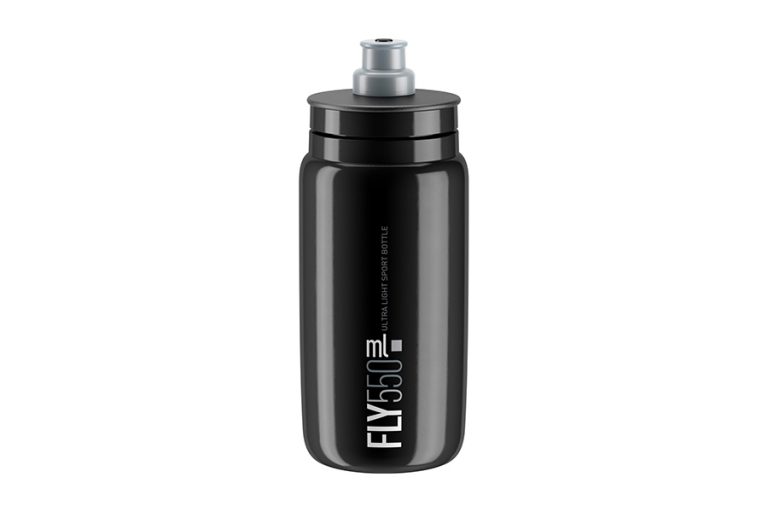
- Volume : 19 fl. oz (550ml)
- Colors : 5
The Elite Fly is a great lightweight water bottle. At only 54g, it won’t worry about weight weenies or weigh down your frame any more than necessary.
With rugged BPA free plastic construction, secure push pull nozzle, flexible material, and excellent durability, this makes an excellent choice if weight is your main criteria.
At 550ml, it won’t carry as much as the Super Corsa but could still last a while on the road. It comes in a range of colors too so you can coordinate your bottle with your frame color.
- Pros : One of the lightest water bottles around.
- Cons : Very thin walls.
Tacx Shiva
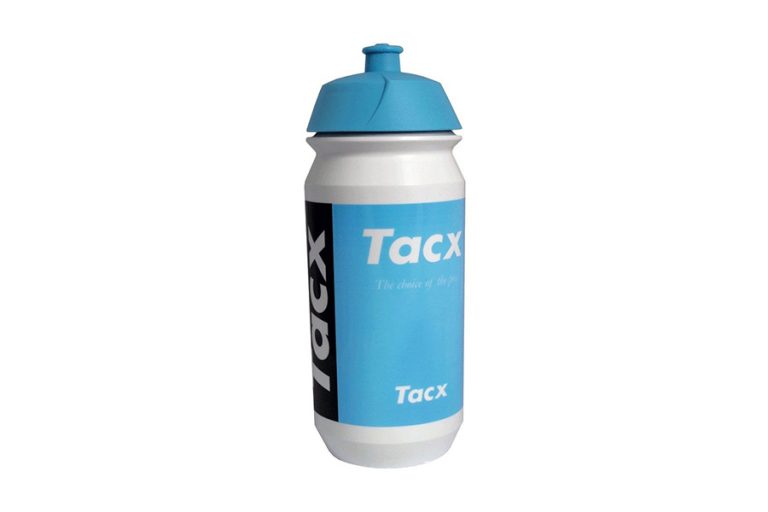
- Volume : 17 fl. oz (500ml)
- Colors : 2
The Tacx Shiva is my pick for the easiest bottle to clean. With a super-simple design, unfussy lid, and simple nozzle, making sure you can effectively clean the bottle after use means these bottles could last years.
At 500ml, it’s a standard size too. The material is soft yet pliable and lends itself to being gripped with or without gloves.
It has a fluted neck which adds security when pulling it from the cage. It’s a small thing but very useful.
- Pros : Easy to clean nozzle.
- Cons : Might not fit securely on other bottle cages.
Camelbak Podium Dirt Series Chill
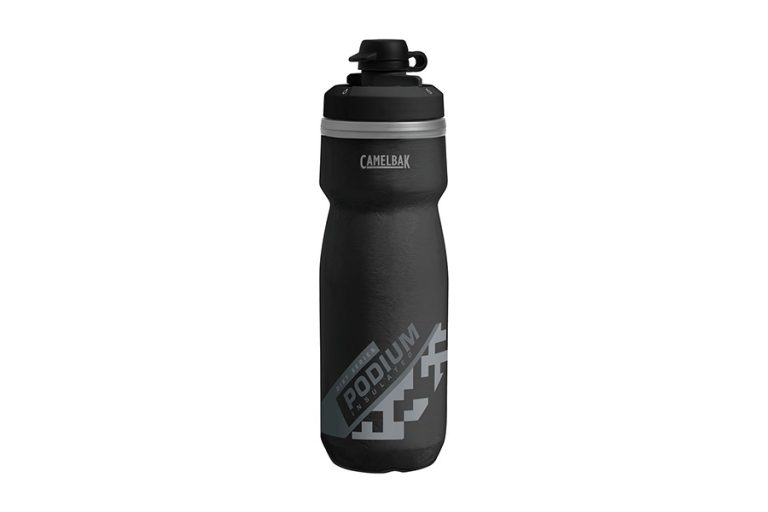
- Volume : 21 fl. oz (620ml)
- Colors : 1
Ever had the unpleasant experience of reaching for a water bottle to hydrate only to take a mouth full of dirt and mud that has been kicked up onto the nozzle? Yuck.
Many mountain bikers can attest to that experience.
Camelback solves this issue with the Podium Dirt Series. It combines its popular core cooler system, which uses double-wall construction and insulation to keep your drinks cool even on the hottest days, with a mud cap that fits over the spill-proof and self-sealing jet valve design to keep dirt out of it and your mouth.
- Pros : Cap prevents mud and sand ingress.
- Cons : Heavier due to the double-wall insulation.
Camelbak Podium Chill
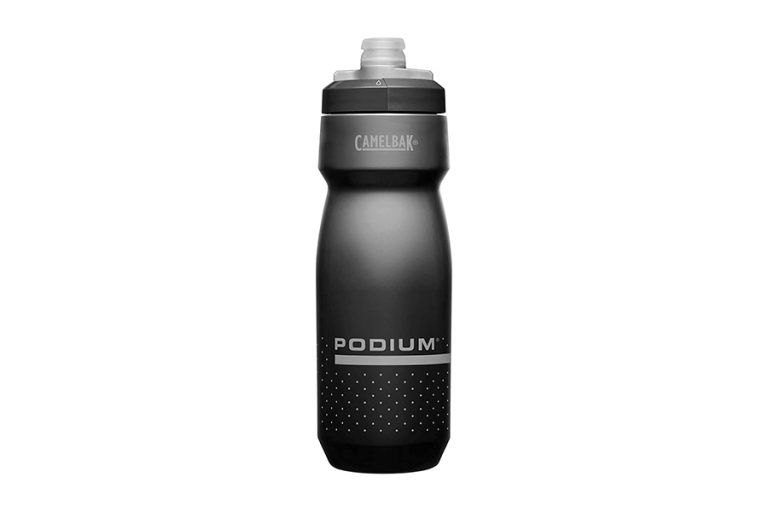
- Volume : 24 fl. oz (710ml)
- Colors : 1
At 710ml, the Camelbak Podium Chill is large enough for most cyclists.
The material is robust, the lid strong and nozzle secured via a twist lock cap, and provides the usual CamelBak quality. The nozzle is one of the most generous in this list, offering more water per gulp and all the others. That can be important especially on very hot days.
Construction quality is excellent with the flexible skin deforming enough to make it comfortable and improving that longevity.
- Pros : Large volume drinking nozzle.
- Cons : Hard to clean.
Fabric Cageless Bottle
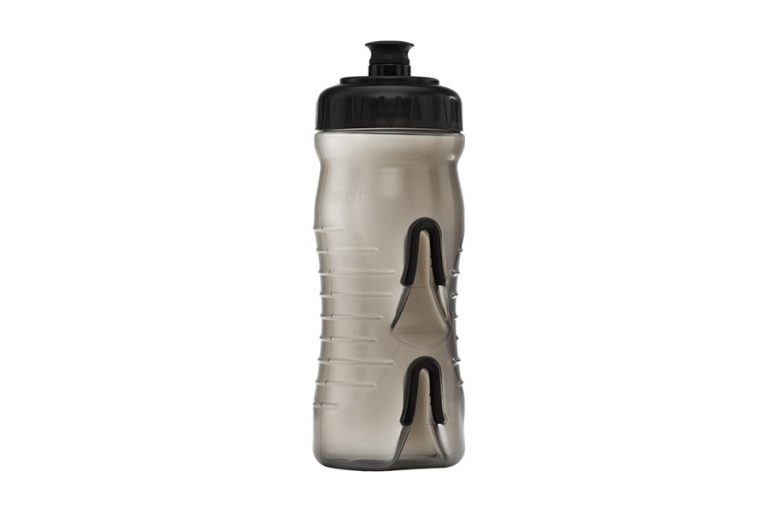
- Volume : 20 fl. oz (600ml)
- Colors : 4
If you don’t like ugly bottle cages, the Fabric Cageless Bottle is the one you’re looking for.
The cageless design means it will fit onto specially designed studs that fit where the bottle cage would. It slots directly onto those studs to provide the same experience without the cage.
Materials quality is good, and the design is strong enough to stay in place on all but the roughest roads. It won’t be much use on gravel or trail, though, but it is good for road riding.
- Pros : Cageless design helps to save some weight on the bottle cages.
- Cons : Needs some practice to slot the water bottle on the move.
Elite Eroica
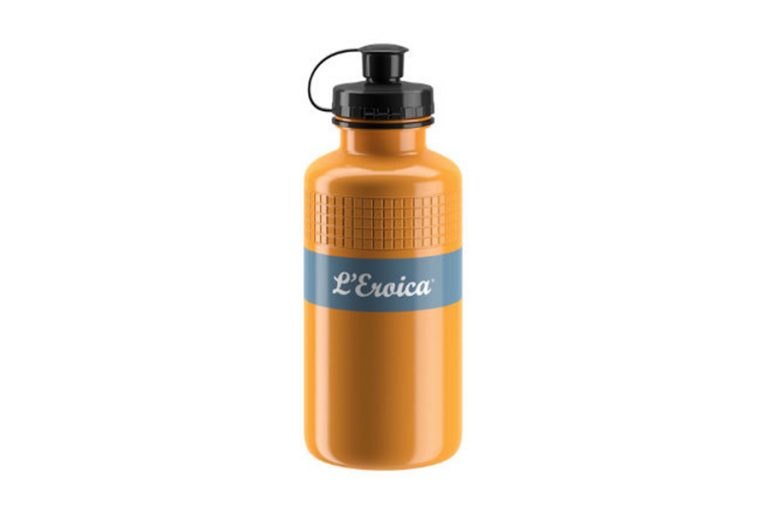
- Volume : 20 fl. oz (600ml)
- Colors : 3
The Elite Eroica is for those who value design and heritage overweight and price. It looks and feels amazing. The design is awesome, almost a work of art in the form of a water bottle. With a definite historical twist, if you ride a steel bike constructed before carbon was a thing, this bottle is for you.
It is made from aluminum and is hand-made with a satin finish. The stopper is made from cork and held on with string just like it used to be. It can carry 600ml securely but weighs a bit.
- Pros : Old school design that suits classic bikes.
- Cons : Expensive.
Arundel Chrono 2
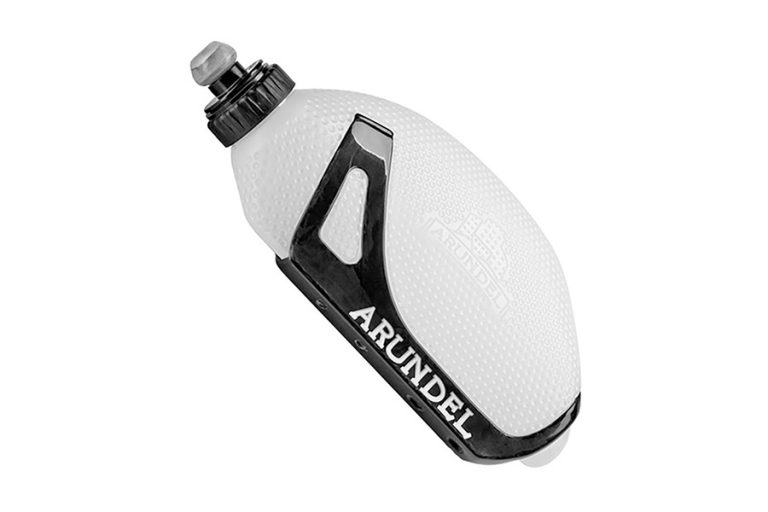
- Volume : 20 fl. oz (600ml)
- Colors : 1
It doesn’t help much if you’ve spent thousands on an aero frame, only to fit it with a bulbous water bottle that serves as an air dam on your bike’s down tube or seat tube.
It an aero shape that will preserve your bike’s previous aerodynamics. The company has also solved past issues for the Chrono that caused it to pop out of the cage on bumpy terrain.
Longer arms on the bottle cage firmly grip the water bottle while making it easier to return to the cage. This bottle and cage, which are UCI compliant, weigh just 136g.
- Pros : Slim profile maintains the aerodynamics of your bike frame design.
- Cons : Expensive.
Water Bottles Buying Guide
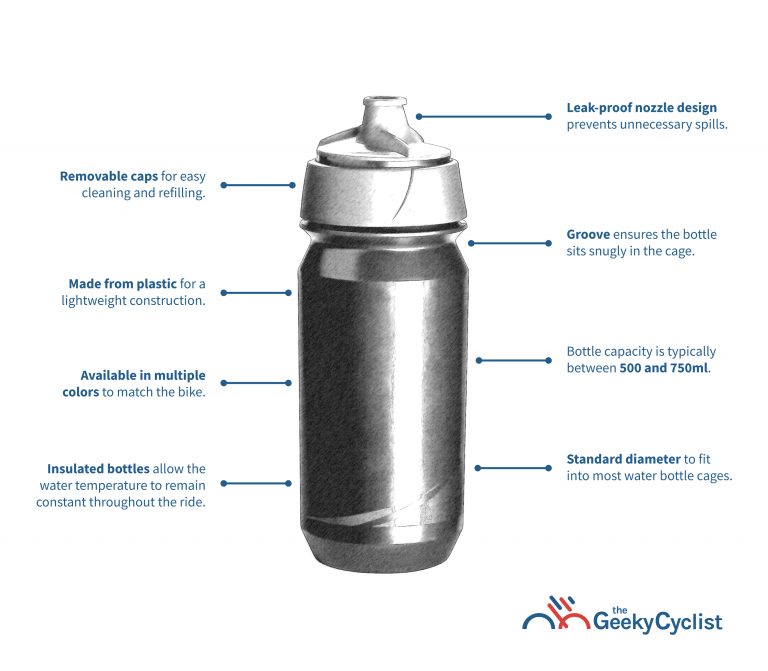
Cycling websites, nutritionists, coaches, and trainers are constantly on us to maintain hydration throughout a ride. As dehydration can reduce stamina and power, it makes sense to drink as much as is practical while out on the bike.
There is more to a water bottle than just buying the color that matches your frame.
Here are 6 things to look out for when buying water bottles.
1. Capacity between 500 to 750ml
Water bottles come in a standard size that will fit the most popular bottle cages and vary in length rather than width. The capacity you choose depends entirely on your drinking habits and how long you generally ride for.
A good example of a large water bottle is the Elite Super Corsa, which has a 750ml capacity.
On average, British Cycling suggests we drink around 500 to 750ml per hour while cycling. The bottle’s size should reflect that and take into account how long you typically ride for and whether you can replenish your bottles during your bike ride.
2. Leak-proof Lid and Nozzle Design
The lid of a water bottle should provide security and prevent leaks. The nozzle design can influence the flow of water from your bottle.
If you like to drink little and often, this won’t matter. If you need to take larger gulps, a larger nozzle design, like the CamelBak might be more useful.
Push-pull or squeeze nozzles both offer leak-proof use. This will come down to personal preference.
3. Bottle Shape
The design is about both looks and comfort. Sure we want our water bottle to look good but we also want it to fit securely in the hand, fit securely in the bottle cage and not drip everywhere.
Bottles with a fluted neck allow you to grip it with a finger while collars or indents help keep the bottle secure in the cage.
4. Made from Safe Materials
Water bottles are generally made of plastic or aluminum, with plastic being the most common. Those materials differ and will usually be either high-density polyethylene (HDPE), low-density polyethylene (LDPE), copolyester, or polypropylene.
Different materials have different characteristics. LDPE makes for more flexible bottles while the others are more rigid.
As long as the material is BPA-free or FDA-certified, it’s perfectly safe for use.
5. Easy to Clean
Cleaning your water bottle properly is key to reducing bacteria buildup and removing any stronger tastes or smells from the bottle.
Plastics are somewhat porous on the inside, so if you drink energy drinks, that taste can permeate the plastic. Effective cleaning not only improves hygiene but can prevent the buildup of those tastes and smells.
Some drinking bottle nozzles are easy to drink from but harder to clean effectively.
Some are very simple to clean, such as the Tacx Shiva. Some bottles are dishwasher safe, while others are not rated for dishwashers.
6. Insulation
Insulated bottles are a quality of life option. They are usually double skinned with an insulating layer between them. They can keep water cool during the heat or stop water from becoming too cold in icy conditions.
If you regularly ride in extremes of temperature or really don’t like drinking warm water, insulated water bottles such as the one from Polar may prove a worthy investment.
Frequently Asked Questions
2. How often should I clean my water bottle?
Clean your water bottle after every ride. Wash both the outer and inner thoroughly.
The outer layer section is usually covered with fine dust, which might not be visible to the eyes. If you used sports drinks, make sure to use a small brush to scrub the inner sections.
3. Why is the water bottle also called a bidon?
Bidon is a French word that translates to the container in English. In cycling crazy countries such as France, Italy, Spain, Belgium, and hardcore cyclists, the water bottle is commonly referred to as a bidon.
4. Do water bottles come in standardized sizes?
Most cycling water bottles come in a standardized circumference. That means that they’ll fit into the majority of bottle cages. The only difference lies in its capacity, which ranges from 500ml to 750ml and even 1000ml.
Author Recommended Reads

